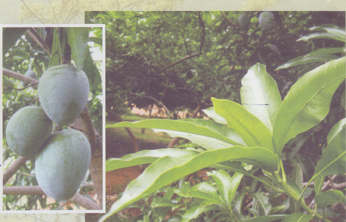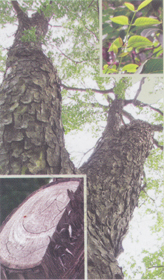
Mango tree
This feature on the trees of Chennai is based on the book Trees and Tree Tales by Prof K.N. Rao, a renowned botanist, published by Oxygen Books, Chennai. It speaks of the biodiversity of the city in the form of trees that have survived continuous human efforts to decimate them. Though the city has more of the showy, colourfully flowered exotic trees than the less ornamental native trees, the latter yield a variety of utilitarian products. Examples abound of the multipurpose coconut, neem, tamarind and palmyrah, all valuable in medicine, food, construction and other areas of human use. Here is a sample of some of the trees common to Chennai, with brief descriptions.
In the service of mankind
The neem tree, Azadirachta indica, is found in most compounds of Chennai homes. According to Brihat Samhita, neem is an “indicator plant” for the presence of underground water. Obvioulsy, artificial watering is unnecessary. The rains meet its water requirements.
The neem has a special place in the hearts of Chennaivasis because it flowers just before the Tamil New Year. The flowers form part of the New Year pachadi lending it a bitter taste and a philosophical message. The neem flower, though bitter to taste, is salutary in effect, because it is vermifugal and kills worms in the intestines.
The various palms
Stand anywhere in Chennai, and look around, you are sure to see coconut trees. Such is the visibility of coconut in Chennai and, indeed, all along the coastal belt of the country. Other palm tree commonly seen in Chennai are: Fish tail palm (Caryota urens), Royal palm (Oreodoxa regia) and Palmyrah plan (Borassus flabelifer).
The last of these is commonly seen on the outskirts of the city, but is not very common in the city itself.
The leguminous trees

Mahogany tree
The legumonosae is a family of flowering plants that exhibits a great diversity of habit and floral organisation. The Gliricidia is a medium-sized tree and its leaves make excellent, rich green manure. ‘Gliiricidia’ means ‘rat-destroying’ and the seeds seem to possess this power.
This is a tree commonly seen in all parts of Chennai, but you are likely to notice it only when it is in flower. But far the most gorgeous of the papilionaceous trees seen in Chennai are the coral tree, botanically christened Erythrina inidica.
Agati Maram, botanically known as Sesbania grandiflora, was, till a few years ago, a very commonly grown tree in the backyards of many a Chennai home.
Delonix regia is a native of Madagascar. It reached India via Mauritius. The tree is found everywhere in Chennai. Gulmohur, a close relative of Delonix (which, incidentally, is called by this generic name by some authors), is the small-sized Caesalpinia pulcherrima often seen in the compounds of many houses in Chennai.
Ringworm cassia is seen in many home gardens in Chennai.
The tamarind tree, Tamarindus indica, is an evergreen tree of great economic importance. It yields puli, much-flavoured ingredient in South India’s sambar. It lives for well over a hundred years and is, therefore, a favourite of the Road and Buildings wing of the Public Works Department.
The rain tree, which is easily the most common avenue tree in Chennai, is botanically called Samanea saman. Albizzia lebbeck, the Siris tree mentioned earlier, is a tall tree, reaching up to 15 m in height.
Sacred trees
Callophyllum inophgyllum, called punnai in Tamil, Punnaga in Sanskrit and the Alexandrian laurel in English, is a much-venerated tree as it is considered the favorite of Lord Krishna.
It is a small-sized tree often grown in many a home garden in Chennai.
A fast-growing tree, called Kattumalli in Tamil, the cork tree with the botanical name of Millingtonia hortensis, gets its name from its fissured bark, which is used as an inferior substitute for cork.
Unfortunately, the peepul is a calciphile (a plant that grows in lime-rich conditions) and is often seen growing on old walls, inviting the punishment of being uprooted. The Senate House of Madras University has been a victim of this tree and due to past negligence, permitting its growth cost a tidy sum to restore that beautiful heritage building.
Ala maram in Tamil, the scientific name of the banyan is Ficus benghalensis. For a Chennaiite, the banyan tree in the gardens of the Theosophycal Society at Adyar is a landmark. Sometime in the 1980s, it fell victim to a cloudburst and all efforts at revitalising its main trunk proved futile.
Called Pavazhamalligai in Tamil, Parijatam in Sanskrt and Telugu and Coral Jasmine in English, it has a tell-tale botanical name – Nyctanthes arborristis: ‘Nyctanthes’ means that which blossoms at nightfall.
The flower is very attractive, with a red corolla tube bearing unequally lobed petals at its top. The petals are snowy white and are usually dotted with dewdrops, for flowering occurs in December when the early hours of the morning are heavy with dew.
Trees with showy flowers
Quite a few of the city’s trees bear large and showy flowers which, for some inexplicable reason, do not feature in local customs and traditions. Many of them are excellent shade-giving trees.
First among them is the Trumper flower, botanically named Stenolobium stans. It is a common tree growing in many home gardens. Tabebuia rosea, another tree of Mexican origin, bears pale mauve flowers also somewhat trumpet-shaped. The flowers are so lightly coloured that they are more noticeable on ground rather than on the tree.
The most common species is Plumeria alba, the white frangipani that often grows in the backyards of many homes in Chennai. Thespesia populnea is a common roadside tree in Chennai. Called Poovarasu in Tamil and Portia tree in English, this salt-tolerant tree is more commonly seen in the coastal belt.
Attractive-leaved trees
Quite a few trees growing in Chennai are conspicuous by their foilage. It is the leaves and not the flowers that hold your attention.
Called Asoka Maram or Nettlingam in Tamil, the Mast tree is botanically known as Polyalthia longifolia. This tree is distinguished by its lofty central column, which grows dead straight with branches that grow in acropetal succession (the youngest branch is near the top and the oldest near the base).
The Indian almond is known as Narvadom in Tamil and botanically as Terminalia catappa. It is a favourite backyard tree in Chennai homes. It is a large deciduous tree with dark green leaves, narrow near the base and broad in the middle.
More commonly known as Karuveppilai or Curry leaf tree, Murraya Koengi belongs to the virus family and as such has leaves studded with oil glands, which are the source of the leaves’ pleasant aroma.
The not-so-common trees
A tree around which a good deal of folklore abounds is Terminalia Arjuna, more commonly known as the Arjun or Marutu in Tamil. The Arjun is a large, evergreen tree with buttressed trunk and a spreading crown from which branches droop downwards. Its bark is smooth, grey on the outside, flesh-coloured inside and flakes off in large, flat pieces. The leaves are simple-somewhat sub-opposite, oblong, dull green above and pale brown beneath. You have quite a few of these trees on the Harrington Road-Spur Tank Road stretch in Chetput.
The White silk cotton tree, or Illavampanju as it is known in Tamil, is far more common in Chennai than the red silk cotton tree. Many a garden sports this tree and Jeeva Park in GN Chetty Road, T Nagar, has quite a few.
The Mahagony tree is a member of the neem family, Meliaceae. Naturally, it shares several features with the neem. For instance, its leaves are feather-like, with the leaflets borne on either side of a central rachis with an unpaired terminal leaflet. However, the leaflets of mahagony are much smaller and have a smooth margin though, of course, a large vein divides them into two unequal portions, as in neem.
This is the rich biodiversity of the city – similarities and dissimilarities growing together within the same family. Teak trees are seen in many parts of Chennai. A few trees grown in the compound of the AG’s Office on Anna Salai have been there for over a half-century now.
There is a full-grown wild almond tree in Chennai on the campus of St George’s (orphanage) on Poonamalle High Road (now called EVR Salai) opposite Pachaiyappa’s College.
Uncommon trees
The baobab, a tree introduced from Africa, by the Arabs, also called the African calabash, is Adansonia Digitata. Its Tamil name is Annaipulli. A couple of baobab trees can be found in the Chepauk cricket grounds, at the eastern end of Wallajah Road where it meets the Buckingham Canal.
Fruit-bearing trees
Called koyya in Tamil, this undertree, botanically known as Psidium guavava, is widely grown throughout India. It is found in many backyards of Chennai homes, receiving no particular care.
Second in popularity to the mango in Chennai is the jack. It is tasty and has medicinal and ritualistic value. The jack tree, botanically called Artocarpus heterophyllusor, Arto carpus integrifolia and palaphazham in Tamil, is native to India
The jack is a large evergreen tree growing up to about 12-14m. Often seen growing in the backyards of Chennai homes, the jack exhibits a variety of peculiar features. – (Courtesy: Matrix, the house journal of the Sanmar Group)
|

